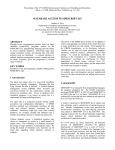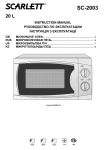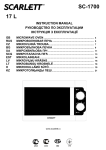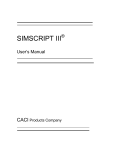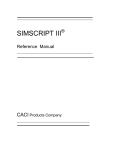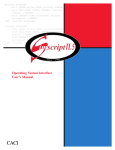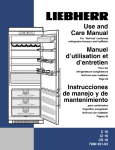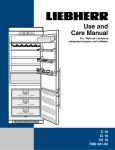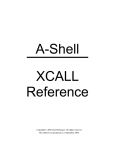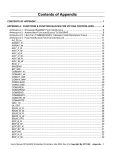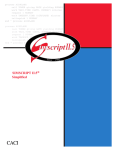Download SIMSCRIPT II.5 Database Connectivity User Manual
Transcript
process AIRPLANE
call TOWER giving GATE yielding RUNWAY
work TAXI.TIME (GATE, RUNWAY) minutes
request 1 RUNWAY
work TAKEOFF.TIME (AIRPLANE) minutes
relinquish 1 RUNWAY
end " process AIRPLANE
S
Since
Database Connectivity
User's Manual
1962
Copyright © 2002 CACI Products Co.
All rights reserved. No part of this publication may be reproduced by any means without written permission
from CACI.
For product information or technical support contact:
CACI Products Company
1011 Camino Del Rio South, Suite 230
San Diego, CA 92108
Phone: (619) 542-5228
Fax: (619) 692-1013
The information in this publication is believed to be accurate in all respects. However, CACI cannot assume
the responsibility for any consequences resulting from the use thereof. The information contained herein is
subject to change. Revisions to this publication or new editions of it may be issued to incorporate such change.
SIMSCRIPT II.5 is a registered trademark of CACI Products Company.
Windows is a registered trademark of Microsoft Corporation.
DB2 is a registered trademark of IBM Corporation.
Oracle is a registered trademark of Oracle Corporation.
Table of Contents
Chapter 1
Introduction to SDBC............................................................. 1
1.1 SETTING UP A DATABASE .............................................................................................1
1.2 DECLARING THE SDBC FUNCTIONS AND ROUTINES .......................................................2
1.3 CONNECTING TO A DATABASE .......................................................................................2
1.4 INTERPRETING RUN-TIME ERRORS ................................................................................3
Chapter 2
SQL Updates........................................................................... 5
2.1 CREATING TABLES .......................................................................................................5
2.2 INSERTING ROWS .........................................................................................................7
2.3 MODIFYING ROWS ........................................................................................................9
2.4 DELETING ROWS ........................................................................................................10
Chapter 3
SQL Queries ......................................................................... 13
3.1 QUERYING THE DATABASE ..........................................................................................13
3.2 SPECIFYING SQL EXPRESSIONS .................................................................................15
3.3 SELECTING ROWS ......................................................................................................17
3.4 JOINING TABLES .........................................................................................................19
Chapter 4
SQL Parameters ................................................................... 23
Chapter 5
Database Transactions........................................................ 25
Chapter 6
Example Program: Bank Simulation .................................. 27
Chapter 7
Example Program: Job Shop Simulation........................... 39
APPENDIX A
SDBC Functions and Routines...................................... 53
APPENDIX B
SQL Syntax...................................................................... 57
APPENDIX C
SQLSTATE Codes........................................................... 61
INDEX ........................................................................................................ 65
i
SIMSCRIPT II.5 Database Connectivity User’s Manual
ii
Chapter 1
Introduction to SDBC
SIMSCRIPT II.5® Database Connectivity (SDBC) is a library of functions and
routines that enables SIMSCRIPT II.5 programs to access databases. SDBC makes
it possible for SIMSCRIPT II.5 programs to create tables in relational databases; to
insert, modify, and delete the rows of database tables; and to perform database
queries.
To use SDBC, it is necessary to have installed a database management system
(DBMS). There are many to choose from, including Microsoft Access, Microsoft
SQL Server, IBM DB2®, IBM Informix, and Oracle®. SDBC provides a common
interface to all of these.
SDBC is patterned after and utilizes Microsoft’s Open Database Connectivity
(ODBC). SDBC works with any DBMS having an ODBC 3.0 driver. SIMSCRIPT
II.5 programs call SDBC functions and routines, which in turn call ODBC functions
that communicate with the DBMS through this driver.
This manual assumes that the reader has a working knowledge of the SIMSCRIPT
II.5 programming language and is familiar with relational database concepts,
including Structured Query Language (SQL).
1.1 Setting Up a Database
The first step is to create a database. Each DBMS provides its own mechanism for
creating a database. For example, a database is created in Microsoft Access by
selecting New from the File menu. Consult the DBMS documentation to learn how
to create a database.
The second step is to define an ODBC data source, which associates an ODBC data
source name with the database and specifies the ODBC 3.0 driver to use. In
Microsoft Windows®, this is accomplished by running the ODBC Data Source
Administrator program which can be found in the Control Panel.
1
SIMSCRIPT II.5 Database Connectivity User’s Manual
1.2 Declaring the SDBC Functions and Routines
The SDBC functions and routines must be declared in the Preamble of the
SIMSCRIPT II.5 program. A text file containing the required declarations is
provided as part of the SDBC installation. Copy the contents of this file into the
Preamble:
preamble
...
''SDBC
define
define
define
define
define
define
define
define
define
define
define
define
define
define
define
define
Functions and Routines
DB.AUTOCOMMIT.R as a
DB.COMMIT.R
as a
DB.CONNECT.R
as a
DB.DISCONNECT.R as a
DB.EXISTS.F
as an integer
DB.FETCH.F
as an integer
DB.GETINT.F
as an integer
DB.GETREAL.F
as a double
DB.GETTEXT.F
as a text
DB.NULL.F
as an integer
DB.QUERY.R
as a
DB.ROLLBACK.R
as a
DB.SETINT.R
as a
DB.SETREAL.R
as a
DB.SETTEXT.R
as a
DB.UPDATE.F
as an integer
routine
routine
routine
routine
function
function
function
function
function
function
routine
routine
routine
routine
routine
function
given
given
given
given
given
given
given
given
given
given
given
given
given
given
given
given
1
0
3
0
1
0
1
1
1
1
1
0
2
2
2
1
argument
arguments
arguments
arguments
argument
arguments
argument
argument
argument
argument
argument
arguments
arguments
arguments
arguments
argument
...
end
1.3 Connecting to a Database
Before any operations can be performed on a database, the SIMSCRIPT II.5
program must first connect to the database. This is accomplished by calling
DB.CONNECT.R:
call DB.CONNECT.R(DSNAME, USERNAME, PASSWORD)
DSNAME is a text value specifying the ODBC data source name associated with the
database.
If the database has been set up for secure access, then text values
USERNAME and PASSWORD must provide a valid user name and password for this
database. If no security has been established for this database, then any user name
and password may be given to this routine. (Consult the DBMS documentation for
information on how to secure a database.)
2
1. Introduction to SDBC
Example:
define USER, PWD as text variables
write as "Enter your database user name:", /
read USER
write as "Enter your database password:", /
read PWD
call DB.CONNECT.R("TESTDB1", USER, PWD)
When finished with the database, the program calls DB.DISCONNECT.R to
disconnect:
call DB.DISCONNECT.R
It is not possible to connect to more than one database at a time. However, after
disconnecting from one database, the program may connect to a second database (or
reconnect to the first database). If the program calls DB.CONNECT.R while already
connected to a database, an implicit disconnection occurs before the new
connection is attempted. A program that terminates while connected to a database
is implicitly disconnected.
1.4 Interpreting Run-time Errors
SIMSCRIPT II.5 run-time error #2400 is generated for every SDBC-related error.
For example, if an invalid ODBC data source name is passed to DB.CONNECT.R, the
following error message may be produced:
RUN-TIME ERROR #2400: [IM002][0][Microsoft][ODBC Driver
Manager] Data source name not found and no default driver
specified
The error message may have come from the DBMS and may be too long to fit in
the SIMSCRIPT II.5 SimDebug display. In this case, the message is truncated:
RUN-TIME ERROR #2400: [23000][-1605][Microsoft][ODBC Microsoft
Access Driver] The changes you requested to the table were
not successful...
Refer to the file named SDBC.log in the current working directory for the full
message:
SDBC Run-time Error, Thu Jan 10 14:03:18 2002
[23000][-1605][Microsoft][ODBC Microsoft Access Driver] The
changes you requested to the table were not successful because
they would create duplicate values in the index, primary key,
3
SIMSCRIPT II.5 Database Connectivity User’s Manual
or relationship. Change the data in the field or fields that
contain duplicate data, remove the index, or redefine the index
to permit duplicate entries and try again.
As illustrated by these examples, an SDBC run-time error message may contain
special information in brackets. The first value in brackets (e.g., 23000) is an
SQLSTATE code; see Appendix C for a list of these codes and their meanings. The
second value in brackets (e.g., -1605) is an error code specific to the DBMS; see
the DBMS documentation for details. The other bracketed information identifies
the vendor, ODBC component, and DBMS from which the error message came.
4
Chapter 2
SQL Updates
After connecting to a database via DB.CONNECT.R, the SIMSCRIPT II.5 program
may pass SQL statements one at a time to the DBMS for processing. An SQL
statement that modifies the database is executed by DB.UPDATE.F, which is
discussed in this section. An SQL statement that queries the database, without
modifying it, is processed by DB.QUERY.R, which is covered in Section 3. The
following is an example of a DB.UPDATE.F call:
NUMROWS = DB.UPDATE.F(COMMAND)
COMMAND is a text value giving the SQL statement to be processed. This function
returns after the given statement has been executed by the DBMS on the connected
database. The integer return value indicates the number of rows affected by the
execution of this statement, if applicable.
2.1 Creating Tables
Passing an SQL CREATE TABLE statement to DB.UPDATE.F creates a database table
A CREATE TABLE statement names the table and its columns, and specifies the data
type for each column. The following SQL data types are supported by almost every
DBMS:
SMALLINT
INTEGER
a signed 16-bit integer
a signed 32-bit integer
REAL
DOUBLE
a single-precision floating-point number
a double-precision floating-point number
CHAR(n)
VARCHAR(n)
a fixed-length character string of length n
a variable-length character string having a maximum length of n
A DBMS may permit a variety of synonyms for these data types, such as SHORT for
SMALLINT; INT or LONG for INTEGER; SINGLE for REAL; DOUBLE PRECISION for
DOUBLE; CHARACTER for CHAR; and CHAR VARYING or CHARACTER VARYING for
VARCHAR. A DBMS may also support a variety of other data types, such as
BOOLEAN, BYTE, COUNTER, DECIMAL, DATE, and TIME. Also, a DBMS may require
that long character strings be stored as a special data type called TEXT, LONGTEXT, or
LONG VARCHAR. Consult the DBMS documentation for details.
5
SIMSCRIPT II.5 Database Connectivity User’s Manual
The following SQL statement creates a table named RESULT. Each row in this table
will record the result of one simulation run.
CREATE TABLE RESULT
(RUNID
INTEGER NOT NULL PRIMARY KEY,
MAXQLEN INTEGER,
AVGQLEN REAL,
COMMENT VARCHAR(80))
This table has four columns: RUNID, MAXQLEN, AVGQLEN, and COMMENT. RUNID holds
an integer ID that uniquely identifies the simulation run; therefore, this column has
been designated as the primary key for the table. MAXQLEN contains an integer value
giving the maximum queue length observed during the run. AVGQLEN holds a
single-precision floating-point value giving the average queue length observed
during the run. COMMENT provides space for a text comment, up to 80 characters in
length. Each column may be undefined and assigned a null value, except RUNID
which has been designated as NOT NULL and must always contain a non-null value.
To create this table, the CREATE TABLE statement is passed as a text value to
DB.UPDATE.F. Since the text value is rather long, we use CONCAT.F to construct it:
define CMD as a text variable
define ROWS as an integer variable
CMD = CONCAT.F(
"CREATE TABLE RESULT ",
"(RUNID
INTEGER NOT NULL PRIMARY KEY,",
" MAXQLEN INTEGER,",
" AVGQLEN REAL,",
" COMMENT VARCHAR(80))")
ROWS = DB.UPDATE.F(CMD)
Upon return from DB.UPDATE.F, a table has been created with the specified name
and columns, containing no rows. The return value in ROWS is undefined and should
be ignored.
To destroy this table, pass a DROP TABLE statement to DB.UPDATE.F:
ROWS = DB.UPDATE.F("DROP TABLE RESULT")
Refer to Appendix B in this manual, and the DBMS documentation, for a
specification of the syntax of the CREATE TABLE and DROP TABLE statements.
CREATE TABLE and DROP TABLE are examples of SQL Data Definition Language
(DDL) statements. A DBMS may support many other types of DDL statements,
TABLE,
CREATE/DROP
VIEW,
CREATE/DROP
INDEX,
including ALTER
6
2. SQL Updates
CREATE/ALTER/DROP DOMAIN, CREATE/DROP ASSERTION, and GRANT/REVOKE. See
the DBMS documentation for details. Any DDL statement may be passed to
DB.UPDATE.F for execution. For all DDL statements, the return value from
DB.UPDATE.F is undefined and should be ignored.
SDBC supplies a function named DB.EXISTS.F to determine whether a table exists.
This function takes a table name as its only argument and returns 1 if the table
exists or 0 if the table does not exist. To avoid a run-time error for attempting to
create a table that already exists, call this function to verify that the table does not
exist before creating it:
if DB.EXISTS.F("RESULT") = 0 ''the table does not exist
''create the table
...
always
Likewise, to avoid a run-time error for attempting to drop a table that does not exist,
call DB.EXISTS.F to verify that the table exists before dropping it:
if DB.EXISTS.F("RESULT") = 1 ''the table exists
''drop the table
...
always
Please note that SIMSCRIPT II.5 programs can access tables that have been created
by other means, such as by an interactive SQL command processor supplied by the
DBMS; and DBMS tools can access tables created by SIMSCRIPT II.5 programs.
2.2 Inserting Rows
To insert a row into a table, an SQL INSERT statement is passed to DB.UPDATE.F.
The following code inserts a row into the RESULT table, setting RUNID to 101,
MAXQLEN to 12, AVGQLEN to 2.75, and COMMENT to "First test run in December":
define CMD as a text variable
define ROWS as an integer variable
CMD = CONCAT.F(
"INSERT INTO RESULT",
" VALUES (101, 12, 2.75, 'First test run in December')")
ROWS = DB.UPDATE.F(CMD)
Upon return from DB.UPDATE.F, the specified row has been inserted into the table.
The return value in ROWS is 1, indicating that one row has been inserted. Note that
7
SIMSCRIPT II.5 Database Connectivity User’s Manual
text literals in SQL are delimited by single quotes, not double quotes as in
SIMSCRIPT II.5.
When one or more columns are undefined, a variant of the SQL INSERT statement
may be used that specifies only the defined columns of the new row. The following
code inserts a row into the RESULT table, setting RUNID to 200 and COMMENT to
"Demo". To MAXQLEN and AVGQLEN, which are omitted, null values are assigned
implicitly. (If the DBMS supports default values, the omitted columns receive their
default values, which may be non-null.)
8
2. SQL Updates
ROWS = DB.UPDATE.F(
"INSERT INTO RESULT (RUNID, COMMENT) VALUES (200, 'Demo')")
Or null values may be specified explicitly for the undefined columns:
ROWS = DB.UPDATE.F(
"INSERT INTO RESULT VALUES (200, NULL, NULL, 'Demo')")
Another variant of the INSERT statement specifies a query and inserts each row
returned by the query.
The INSERT statement is an SQL Data Manipulation Language (DML) statement.
Refer to Appendix B in this manual, and the DBMS documentation, for a
specification of its syntax.
2.3 Modifying Rows
To modify the value of one or more columns in one or more rows, an SQL UPDATE
statement is passed to DB.UPDATE.F. The following code changes the values of
MAXQLEN to 10 and AVGQLEN to 2.25 in the row that has RUNID equal to 101:
define CMD as a text variable
define ROWS as an integer variable
CMD = CONCAT.F(
"UPDATE RESULT",
" SET MAXQLEN = 10, AVGQLEN = 2.25",
" WHERE RUNID = 101")
ROWS = DB.UPDATE.F(CMD)
Upon return from DB.UPDATE.F, the requested modification has been performed.
The return value in ROWS indicates the number of rows modified. Presumably
ROWS=1 in our example; however, it could be zero if there does not exist a row
having RUNID=101, or greater than one if more than one row has RUNID=101.
If no WHERE clause is specified in the UPDATE statement, then the modification is
applied to every row in the table. For example, the following code adds 1000 to
every RUNID:
ROWS = DB.UPDATE.F("UPDATE RESULT SET RUNID = RUNID + 1000")
In this case, the return value in ROWS equals the number of rows in the table since
every row was modified.
9
SIMSCRIPT II.5 Database Connectivity User’s Manual
The following example sets the COMMENT field to null for every RUNID greater than
1200:
ROWS = DB.UPDATE.F(
"UPDATE RESULT SET COMMENT = NULL WHERE RUNID > 1200")
The WHERE clause may specify any conditional expression allowed in SQL.
Expressions are discussed in Section 3.2.
The UPDATE statement is an SQL Data Manipulation Language (DML) statement.
Refer to Appendix B in this manual, and the DBMS documentation, for a
specification of its syntax.
2.4 Deleting Rows
To delete one or more rows, an SQL DELETE statement is passed to DB.UPDATE.F.
The following code deletes the row that has RUNID equal to 101:
define ROWS as an integer variable
ROWS = DB.UPDATE.F("DELETE FROM RESULT WHERE RUNID = 101")
Upon return from DB.UPDATE.F, the requested deletion has been performed. The
return value in ROWS indicates the number of rows deleted. Presumably ROWS=1 in
our example; however, it could be zero if there did not exist a row having
RUNID=101, or greater than one if more than one row had RUNID=101.
If no WHERE clause is specified in the DELETE statement, then every row in the table
is deleted:
ROWS = DB.UPDATE.F("DELETE FROM RESULT")
In this case, the return value in ROWS equals the number of rows that were in the
table before they were all deleted.
The following example deletes all rows having a RUNID greater than or equal to
1000 and less than 2000:
ROWS = DB.UPDATE.F(
"DELETE FROM RESULT WHERE RUNID >= 1000 AND RUNID < 2000")
The WHERE clause may specify any conditional expression allowed in SQL.
Expressions are discussed in Section 3.2.
10
2. SQL Updates
The DELETE statement is an SQL Data Manipulation Language (DML) statement.
Refer to Appendix B in this manual, and the DBMS documentation, for a
specification of its syntax.
11
Chapter 3
SQL Queries
After connecting to a database via DB.CONNECT.R, the SIMSCRIPT II.5 program
may submit queries to the DBMS for processing. The SQL SELECT statement is
used to query the database. After executing a query, the rows returned by the query
are retrieved by the program.
3.1 Querying the Database
Any SELECT statement may be passed as a text value to DB.QUERY.R for execution:
call DB.QUERY.R("SELECT ...")
The rows returned by the query are then fetched one at a time by calling
DB.FETCH.F for each row. This function returns 1 if it has successfully fetched the
next row and returns 0 when there are no more rows.
After fetching a row, the values of the columns in the row are obtained by calling
DB.GETINT.F for each integer column, DB.GETREAL.F for each floating-point
column, and DB.GETTEXT.F for each character-string column.
The following query returns all rows in the table named RESULT:
SELECT * FROM RESULT
The asterisk is shorthand for listing all of the columns of the table, in the order in
which they were defined in the CREATE TABLE statement. So the above query is
equivalent to:
SELECT RUNID, MAXQLEN, AVGQLEN, COMMENT FROM RESULT
The following code is typical of SDBC query processing. First, the query is
executed, and then a while loop fetches the rows returned by the query. For each
row, the column values are obtained and then some code is executed that uses these
values. In this example, program variables are given the same names as columns,
but this is done only for clarity and is not a requirement. However, the modes of
these variables should match the SQL data types of the columns.
13
SIMSCRIPT II.5 Database Connectivity User’s Manual
define RUNID, MAXQLEN as integer variables
define AVGQLEN as a real variable
define COMMENT as a text variable
''execute the query
call DB.QUERY.R("SELECT * FROM RESULT")
''fetch the rows
while DB.FETCH.F = 1
do
''a row has been fetched;
''now obtain the value of each column
RUNID
= DB.GETINT.F(1)
MAXQLEN = DB.GETINT.F(2)
AVGQLEN = DB.GETREAL.F(3)
COMMENT = DB.GETTEXT.F(4)
''do some processing using these values
...
loop
One row is processed in each iteration of the while loop. DB.FETCH.F returns 0
when there are no more rows, which terminates the loop.
A column number is the ordinal position of a column within a row. For this query,
RUNID is column number 1, MAXQLEN is column number 2, AVGQLEN is column
number 3, and COMMENT is column number 4. DB.GETINT.F, DB.GETREAL.F, and
DB.GETTEXT.F return the value of the column identified by the given column
number. Specifying a column number less than 1 or greater than the number of
columns produces a run-time error.
When the value of a column is null, DB.GETINT.F returns 0, DB.GETREAL.F returns
0.0, and DB.GETTEXT.F returns the zero-length string (""). However, these values
can also be returned for non-null columns. Therefore, SDBC supplies a function
named DB.NULL.F to determine whether a column contains a null value. This
function accepts a column number as its only argument and returns 1 if the value of
the column is non-null and returns 0 if the value is null. For example:
if DB.NULL.F(3) = 0 ''column number 3 is null
...
always
if DB.NULL.F(2) = 1 ''column number 2 is non-null
...
always
Note that DB.GETINT.F, DB.GETREAL.F, DB.GETTEXT.F, and DB.NULL.F refer only
to the most recently fetched row. It is not possible to access any other row.
Likewise, DB.FETCH.F fetches only rows returned by the most recent query. It is
not possible to fetch rows returned by a prior query.
14
3. SQL Queries
It is not necessary to retrieve all column values if the program only needs some. It
is also not required to fetch all of the rows returned by the query; that is, the
program may terminate the while loop early, before all rows have been retrieved.
After DB.FETCH.F has returned 0, which indicates there are no more rows to be
fetched, calling DB.FETCH.F again, without first executing a new query, produces a
run-time error.
If DB.GETINT.F is called to retrieve a floating-point column value, it returns the
value rounded to the nearest integer. If DB.GETREAL.F retrieves an integer column
value, it returns the value as a real number. If DB.GETINT.F or DB.GETREAL.F
retrieves a character-string column value, it attempts to convert the value to a
number. If DB.GETTEXT.F retrieves an integer or floating-point column value, it
converts the value to text.
3.2 Specifying SQL Expressions
Like SIMSCRIPT II.5 names, SQL names are case-insensitive and may consist of
any combination of letters and digits; however, an SQL name must begin with a
letter. An SQL name may not contain periods unless it is a qualified name, such as
a column name qualified by a table name (e.g., RESULT.RUNID). An SQL name
may contain underscores (e.g., FIRST_NAME). See the DBMS documentation for a
list of reserved SQL key words (e.g., SELECT, FROM, INSERT), which may not be
used to name a table or column.
Numeric constants in SQL and SIMSCRIPT II.5 are specified in the same way,
except that SQL permits scientific notation in constants (e.g., 3.87E-4). Text
literals in SQL are delimited by 'single quotes', rather than "double quotes" as in
SIMSCRIPT II.5: 'This is an SQL text literal', 'Embedded quotes
aren''t a problem', the zero-length string looks like this ''.
SQL and SIMSCRIPT II.5 share the following operators:
+
-
*
/
AND
OR
=
<>
<
>
<=
>=
In SQL, NOT may be used for logical negation. SQL does not have an
exponentiation operator (**) and does not support any of the English abbreviations
(e.g., EQ, LT) or phrases (e.g., EQUALS, LESS THAN) allowed in SIMSCRIPT II.5.
SQL permits the following expressions to test for nulls: X IS NULL, X IS NOT
NULL.
SIMSCRIPT II.5's concise 0 < X < 100 must be expressed in SQL as
0 < X AND X < 100. However, 0 <= X <= 100 may be expressed in SQL as
X BETWEEN 0 AND 100. Its negation, expressed as 0 <= X <= 100 IS FALSE in
15
SIMSCRIPT II.5 Database Connectivity User’s Manual
SIMSCRIPT II.5, is expressed in SQL as NOT (X BETWEEN 0 AND 100) or simply,
X NOT BETWEEN 0 AND 100.
16
3. SQL Queries
SQL's IN operator provides convenient shorthand for testing whether a column
value belongs to a list of values:
X IN (20, 21, 26, 31, 32)
CITY NOT IN ('Detroit', 'Chicago', 'Cincinnati')
In SQL, a SELECT statement known as a subquery may appear within an expression.
Given a subquery as an operand, the IN operator returns true if a given value is
returned by the subquery, and the EXISTS operator returns true if the subquery
returns at least one row. A scalar subquery returns the value of a single column in
a single row.
Full treatment of SQL expressions is beyond the scope of this manual. Please refer
to a book on SQL and the DBMS documentation for more information.
3.3 Selecting Rows
The WHERE clause in a SELECT statement specifies an SQL conditional expression.
Only rows for which the expression evaluates to true are returned by the query. The
following query returns the RUNID, AVGQLEN, and COMMENT columns of each row in
RESULT that has a RUNID between 2000 and 2999 and an AVGQLEN greater than or
equal to 2.0:
SELECT RUNID, AVGQLEN, COMMENT
FROM RESULT
WHERE RUNID BETWEEN 2000 AND 2999
AND AVGQLEN >= 2.0
The rows returned by a query are unordered unless an ORDER BY clause is specified.
To sort the rows by descending AVGQLEN and then by ascending RUNID for rows
having the same AVGQLEN, the following clause is appended to the SELECT
statement:
ORDER BY AVGQLEN DESC, RUNID ASC
Because ascending is the default, the ASC key word may be omitted. Column
numbers may be specified in place of the column names. For this query, RUNID is
column number 1, AVGQLEN is column number 2, and COMMENT is column number 3;
therefore, the following ORDER BY clause is equivalent to the one above:
ORDER BY 2 DESC, 1
The following code executes the above query and prints the five longest average
queue lengths. If the query returns fewer than five rows, then all of the rows will be
17
SIMSCRIPT II.5 Database Connectivity User’s Manual
fetched and printed. If the query returns more than five rows, then only the first
five will be fetched and printed.
define CMD as a text variable
define I
as an integer variable
''construct the query
CMD = CONCAT.F(
"SELECT RUNID, AVGQLEN, COMMENT FROM RESULT",
" WHERE RUNID BETWEEN 2000 AND 2999 AND AVGQLEN >= 2.0",
" ORDER BY 2 DESC, 1")
''execute the query
call DB.QUERY.R(CMD)
''print column headings
print 1 line as follows
AVGQLEN
RUNID
COMMENT
''fetch and print the first five rows
for I = 1 to 5 while DB.FETCH.F = 1
print 1 line with DB.GETREAL.F(2), DB.GETINT.F(1),
DB.GETTEXT.F(3) as follows
*.**
*
******************************
The output might look like this:
AVGQLEN
118.38
41.91
17.00
17.00
14.96
RUNID
2391
2877
2017
2018
2450
COMMENT
Extremely slow server
Test M7
Test M8
Tried a Weibull distribution
In this example, the row with RUNID=2877 has a null COMMENT, which is returned by
DB.GETTEXT.F as a zero-length string ("") and gets printed as blanks.
SQL provides the following aggregate functions:
COUNT(*)
AVG(column)
MAX(column)
MIN(column)
SUM(column)
returns the number of rows
returns the average of the values in column
returns the largest value in column
returns the smallest value in column
returns the sum of the values in column
The following code uses aggregate functions to report the number of rows in
RESULT and the minimum, maximum, and average value of AVGQLEN:
18
3. SQL Queries
''execute the query
call DB.QUERY.R(CONCAT.F(
"SELECT COUNT(*), MIN(AVGQLEN), MAX(AVGQLEN), AVG(AVGQLEN)",
" FROM RESULT"))
if DB.FETCH.F = 1 ''fetched the only row
write DB.GETINT.F(1), DB.GETREAL.F(2), DB.GETREAL.F(3),
DB.GETREAL.F(4) as "In ", I 4,
" simulation runs, the average queue length", /,
"ranged from ", D(4,2), " to ", D(6,2),
" with an average of ", D(5,2), ".", /
always
The output might look like this:
In 3236 simulation runs, the average queue length
ranged from 0.15 to 172.81 with an average of 8.39.
Aggregate functions are commonly applied to groups of rows specified in GROUP
BY and HAVING clauses of a SELECT statement.
The SELECT statement is an SQL Data Manipulation Language (DML) statement.
Refer to Appendix B in this manual, and the DBMS documentation, for a
specification of its syntax.
3.4 Joining Tables
One of the most important database operations is the ability to join two or more
tables. This section illustrates a query that joins two tables.
In the RESULT table, each row records the result of one simulation run and each run
is identified by a unique RUNID. Suppose there exists a second table, named
DETAIL, with the following definition:
CREATE TABLE DETAIL
(RUNID
INTEGER
START_TIME REAL
END_TIME
REAL
QLEN
INTEGER
NOT
NOT
NOT
NOT
NULL,
NULL,
NULL,
NULL)
A row in DETAIL indicates there was a constant queue length (QLEN) from
simulation time START_TIME to END_TIME in the simulation run identified by RUNID.
The DETAIL and RESULT tables have a many-to-one relationship: for each row in
RESULT, there are many rows in DETAIL. In SIMSCRIPT II.5 terminology, this
relationship may be described in terms of entities and sets: each RESULT entity owns
a set of DETAIL entities.
19
SIMSCRIPT II.5 Database Connectivity User’s Manual
With this detailed information, a simulation run can be analyzed in greater depth.
The following code calculates and displays the total simulation time for each queue
length for run #2300:
define JOIN as a text variable
define MAXQLEN, QLEN as integer variables
define DURATION as a 1-dimensional real array
''construct a query that joins tables RESULT and DETAIL;
''since RUNID names a column in both tables, it must be
''qualified by the table name
JOIN = CONCAT.F(
"SELECT RESULT.RUNID, AVGQLEN, MAXQLEN,",
"
END_TIME – START_TIME, QLEN",
" FROM RESULT, DETAIL",
''the tables to join
" WHERE RESULT.RUNID = DETAIL.RUNID", ''how to join them
"
AND RESULT.RUNID = 2300")
''execute the query
call DB.QUERY.R(JOIN)
if DB.FETCH.F = 0 ''the query returned no rows
write as "There is no record of this simulation run", /
else ''fetched the first row
write DB.GETINT.F(1) as "Run #", I 4, /
write as "Average queue length: "
if DB.NULL.F(2) = 1 ''AVGQLEN is non-null
write DB.GETREAL.F(2) as D(5,2), /
else ''AVGQLEN is null
write as "undefined", /
always
if DB.NULL.F(3) = 0 ''MAXQLEN is null
write as "Maximum queue length: undefined", /
else ''MAXQLEN is non-null
MAXQLEN = DB.GETINT.F(3)
''reserve an array with one element for each possible
''queue length; queue length ranges from 0 to MAXQLEN so
''(MAXQLEN+1) elements are needed; the duration for queue
''length I is summed in element (I+1)
reserve DURATION(*) as MAXQLEN + 1
add DB.GETREAL.F(4) to DURATION(DB.GETINT.F(5) + 1)
while DB.FETCH.F = 1 ''fetched another row
add DB.GETREAL.F(4) to DURATION(DB.GETINT.F(5) + 1)
''display the distribution of queue lengths
write as /, "QLEN DURATION", /
for QLEN = 0 to MAXQLEN
write QLEN, DURATION(QLEN + 1) as I 4, "
20
", D(8,2), /
3. SQL Queries
release DURATION(*)
always
always
The output might look like this:
Run #2300
Average queue length:
QLEN
0
1
2
3
4
5
6
7
8
9
10
11
12
13
14
15
3.28
DURATION
157.41
281.31
479.98
394.01
317.84
231.09
141.33
89.77
46.62
28.16
12.79
6.13
2.01
0.89
0.32
0.13
21
Chapter 4
SQL Parameters
The query in Section 3.4 retrieves the data for run #2300. To process the same
query on a different run, the value 2300 needs to be changed in the query. Rather
than modify the query string for every new run ID, an SQL parameter, in the form
of a question mark (?), may be specified in the query as a placeholder for the run
ID. The value of this parameter is set prior to the execution of the query. For
example:
define JOIN as a text variable
define RUNID as an integer variable
''construct a query that uses an SQL parameter
JOIN = CONCAT.F(
"SELECT RESULT.RUNID, AVGQLEN, MAXQLEN,",
"
END_TIME – START_TIME, QLEN",
" FROM RESULT, DETAIL",
" WHERE RESULT.RUNID = DETAIL.RUNID",
"
AND RESULT.RUNID = ?")
''read the run ID
write as "Enter Run #:", /
read RUNID
''set the parameter value
call DB.SETINT.R(1, RUNID)
''execute the query using the parameter value
call DB.QUERY.R(JOIN)
The routine DB.SETINT.R sets the value of the parameter to the value of the RUNID
variable. This value is used in place of the question mark when the query is
executed by DB.QUERY.R. DB.SETINT.R is used to set an integer parameter;
DB.SETREAL.R sets a floating-point parameter; and DB.SETTEXT.R sets a characterstring parameter.
23
SIMSCRIPT II.5 Database Connectivity User’s Manual
The following example from Section 2.2 illustrates how to insert a row into the
RESULT table:
define CMD as a text variable
define ROWS as an integer variable
CMD = CONCAT.F(
"INSERT INTO RESULT",
" VALUES (101, 12, 2.75, 'First test run in December')")
ROWS = DB.UPDATE.F(CMD)
If the column values for the new row are stored in program variables, then it takes
some effort to construct this query. However, using SQL parameters, the task
becomes easier:
define ROWS, RUNID, MAXQLEN as integer variables
define AVGQLEN as a real variable
define COMMENT as a text variable
''set the value of variables RUNID, MAXQLEN, AVGQLEN,
''and COMMENT to the column values of a new row
...
''set four parameter values
call DB.SETINT.R(1, RUNID)
call DB.SETINT.R(2, MAXQLEN)
call DB.SETREAL.R(3, AVGQLEN)
call DB.SETTEXT.R(4, COMMENT)
''insert the new row
ROWS = DB.UPDATE.F("INSERT INTO RESULT VALUES (?, ?, ?, ?)")
A parameter number is the ordinal position of a parameter (i.e., question mark)
within an SQL statement. In this example, DB.SETINT.R sets parameter numbers 1
and 2 to integer values; DB.SETREAL.R sets parameter number 3 to a floating-point
value; and DB.SETTEXT.R sets parameter number 4 to a text value. Failing to set a
parameter before executing the SQL statement produces a run-time error.
Specifying a parameter number less than 1 is also an error. Specifying a parameter
number greater than the number of question marks is not an error; the extra
parameter is simply ignored. Multiple parameters may be set in any order. It is not
possible to set a parameter to a null value.
After the SQL statement has been processed by DB.QUERY.R or DB.UPDATE.F, all
parameter values become undefined and must be set again before the next SQL
statement with parameters is executed.
24
Chapter 5
Database Transactions
A database transaction is an atomic sequence of modifications to a database in
which all or none of the modifications are made permanent. If the transaction is
committed, then all of the changes are made permanent. If the transaction is rolled
back, then all modifications made during the transaction are undone and the
database is returned to the state it was in before the transaction was started.
A database may be shared and accessed concurrently by multiple users and
executing programs. Transactions prevent them from seeing one another's
uncommitted changes to the database, i.e., their work in progress. In addition,
transactions enable the DBMS to restore a database to a known state following a
system or program failure.
When Auto-Commit is ON, each SQL statement executed by DB.UPDATE.F is its
own transaction. That is, either the statement completes successfully and all
changes made by the statement are made permanent (the transaction is committed),
or the statement fails and all changes made by the statement are undone (the
transaction is rolled back). Auto-Commit is ON by default.
To execute two or more SQL statements atomically within a single transaction, it is
necessary to turn Auto-Commit OFF. This is accomplished by passing zero to
DB.AUTOCOMMIT.R:
call DB.AUTOCOMMIT.R(0)
With Auto-Commit OFF, all executed SQL statements are part of the same
transaction, which is terminated by calling DB.COMMIT.R or DB.ROLLBACK.R. To
save all changes made to the database during the transaction:
call DB.COMMIT.R
To undo all changes made to the database during the transaction:
call DB.ROLLBACK.R
After terminating a transaction, a new transaction is begun implicitly.
25
SIMSCRIPT II.5 Database Connectivity User’s Manual
The following code atomically deletes all rows associated with a given simulation
run from tables RESULT and DETAIL:
define RUNID, DELETED as integer variables
''turn Auto-Commit OFF
call DB.AUTOCOMMIT.R(0)
''read the run ID
write as "Enter # of Run to Delete:", /
read RUNID
''delete the RESULT row
call DB.SETINT.R(1, RUNID)
DELETED = DB.UPDATE.F("DELETE FROM RESULT WHERE RUNID = ?")
''delete all DETAIL rows
call DB.SETINT.R(1, RUNID)
add DB.UPDATE.F("DELETE FROM DETAIL WHERE RUNID = ?")
to DELETED
''end the current transaction,
''making all of the deletions permanent
call DB.COMMIT.R
if DELETED = 0
write RUNID as "There are no rows to delete for Run #", I 4,
".", /
else
write DELETED, RUNID as "All ", I 4, " rows for Run #", I 4,
" have been deleted.", /
always
The output might look like this:
All
387 rows for Run #1542 have been deleted.
Once Auto-Commit has been turned OFF, it remains OFF until it is explicitly
turned ON by passing a non-zero value to DB.AUTOCOMMIT.R:
call DB.AUTOCOMMIT.R(1)
Turning Auto-Commit ON implicitly terminates and commits the current
transaction. When Auto-Commit is ON, calling DB.COMMIT.R or DB.ROLLBACK.R
has no effect.
Any transaction that is ongoing when a SIMSCRIPT II.5 program terminates is
automatically rolled back by the DBMS.
26
.
Chapter 6
Example Program: Bank Simulation
This section presents a complete SIMSCRIPT II.5 example program that calls
SDBC functions and routines. This program simulates a bank with a single queue
and multiple tellers and keeps track of simulation runs in a database. Each run is
recorded as one row in a database table with the following definition:
CREATE TABLE BANKSIM
(RUNID
INTEGER NOT
TELLERS INTEGER NOT
IATIME REAL
NOT
SRVTIME REAL
NOT
UTIL
REAL,
AVGQLEN REAL,
MAXQLEN INTEGER)
NULL PRIMARY KEY,
NULL,
NULL,
NULL,
RUNID is an integer ID that uniquely identifies the run. The input parameters are
recorded in columns TELLERS, IATIME, and SRVTIME. TELLERS is the number of
tellers working at the bank. The interarrival time of customers is exponentially
distributed with a mean of IATIME minutes. The time required for a teller to serve a
customer is exponentially distributed with a mean of SRVTIME minutes. The results
of the run are stored in columns UTIL, AVGQLEN, and MAXQLEN. UTIL is the
utilization of the tellers. AVGQLEN and MAXQLEN are the average and maximum
length of the queue, respectively.
The main routine begins by prompting the user for the data source name, user name,
and password, and then connects to the specified database. If the BANKSIM table
does not exist, the CREATE.TABLE routine is called to create it. Then the MAIN.LOOP
routine takes over and repeatedly displays a menu of choices, obtains the user's
choice and processes it.
The user may choose to Define a Run by entering the ID and input parameters for a
new run. A row is inserted into the BANKSIM table containing the specified RUNID,
TELLERS, IATIME, and SRVTIME, with null values in the result columns, UTIL,
AVGQLEN, and MAXQLEN.
The user may choose to Execute a Run by entering the ID of a defined run. The
program obtains the input parameters for this run by retrieving its row. It then
simulates one eight-hour day at the bank using these parameters. The results of the
simulation are displayed to the user and saved in the UTIL, AVGQLEN, and MAXQLEN
columns of the row.
27
SIMSCRIPT II.5 Database Connectivity User’s Manual
The user may choose to Show All Runs; all rows of the BANKSIM table are retrieved
and displayed, sorted by RUNID. The user may choose to Delete a Run by entering
its ID; the row corresponding to this run is deleted from the BANKSIM table.
Finally, the user may choose to Exit, thereby terminating the MAIN.LOOP routine.
The main routine then disconnects from the database and the program terminates.
preamble
''SDBC Example Program
''Single-Queue Multiple-Teller Bank Simulation
''Derived from Example 5 in the book,
'' "Building Simulation Models with SIMSCRIPT II.5"
'' by Edward C. Russell (CACI, 1983)
processes include GENERATOR and CUSTOMER
resources include TELLER
define MEAN.INTERARRIVAL.TIME, MEAN.SERVICE.TIME
as real variables
accumulate UTILIZATION as the average of N.X.TELLER
accumulate AVG.QUEUE.LENGTH as the average
and MAX.QUEUE.LENGTH as the maximum of N.Q.TELLER
''SDBC
define
define
define
define
define
define
define
define
define
define
define
define
define
define
define
define
end
28
Functions and Routines
DB.AUTOCOMMIT.R as a
DB.COMMIT.R
as a
DB.CONNECT.R
as a
DB.DISCONNECT.R as a
DB.EXISTS.F
as an integer
DB.FETCH.F
as an integer
DB.GETINT.F
as an integer
DB.GETREAL.F
as a double
DB.GETTEXT.F
as a text
DB.NULL.F
as an integer
DB.QUERY.R
as a
DB.ROLLBACK.R
as a
DB.SETINT.R
as a
DB.SETREAL.R
as a
DB.SETTEXT.R
as a
DB.UPDATE.F
as an integer
routine
routine
routine
routine
function
function
function
function
function
function
routine
routine
routine
routine
routine
function
given
given
given
given
given
given
given
given
given
given
given
given
given
given
given
given
1
0
3
0
1
0
1
1
1
1
1
0
2
2
2
1
argument
arguments
arguments
arguments
argument
arguments
argument
argument
argument
argument
argument
arguments
arguments
arguments
arguments
argument
6. Example Program: Bank Simulation
main
define DSNAME, USERNAME, PASSWORD as text variables
write as "Enter data source name:", /
read DSNAME
write as "Enter user name:", /
read USERNAME
write as "Enter password:", /
read PASSWORD
call DB.CONNECT.R(DSNAME, USERNAME, PASSWORD)
if DB.EXISTS.F("BANKSIM") = 0 ''BANKSIM table does not exist
call CREATE.TABLE
''so create it
always
create every TELLER(1)
call MAIN.LOOP
call DB.DISCONNECT.R
end
routine CREATE.TABLE
define SQL as a text variable
define ROWS as an integer variable
''construct an SQL CREATE TABLE statement
SQL = CONCAT.F(
"CREATE TABLE BANKSIM ",
"(RUNID
INTEGER NOT NULL PRIMARY KEY,",
" TELLERS INTEGER NOT NULL,",
" IATIME REAL
NOT NULL,",
" SRVTIME REAL
NOT NULL,",
" UTIL
REAL,",
" AVGQLEN REAL,",
" MAXQLEN INTEGER)")
''create the table
ROWS = DB.UPDATE.F(SQL)
end
29
SIMSCRIPT II.5 Database Connectivity User’s Manual
routine MAIN.LOOP
define CHOICE as an integer variable
'DISPLAY.MENU'
print 7 lines thus
Enter
0 to Exit
1 to Define a Run
2 to Execute a Run
3 to Show All Runs
4 to Delete a Run
read CHOICE
select case CHOICE
case 0 return
case 1 call DEFINE.RUN
case 2 call EXECUTE.RUN
case 3 call SHOW.RUNS
case 4 call DELETE.RUN
default write as "Invalid choice", /
endselect
go to 'DISPLAY.MENU'
end
30
6. Example Program: Bank Simulation
routine DEFINE.RUN
define RUNID, TELLERS, ROWS as integer variables
define IATIME, SRVTIME as real variables
write as /, "Enter Run #:", /
read RUNID
call DB.SETINT.R(1, RUNID)
call DB.QUERY.R("SELECT COUNT(*) FROM BANKSIM WHERE RUNID = ?")
if DB.FETCH.F = 1 and DB.GETINT.F(1) > 0
write as "Run already defined", /
return
otherwise
write as "Enter # of Tellers:", /
read TELLERS
write as "Enter Mean InterArrival Time in Minutes:", /
read IATIME
write as "Enter Mean Service Time in Minutes:", /
read SRVTIME
call DB.SETINT.R(1, RUNID)
call DB.SETINT.R(2, TELLERS)
call DB.SETREAL.R(3, IATIME)
call DB.SETREAL.R(4, SRVTIME)
ROWS = DB.UPDATE.F(CONCAT.F(
"INSERT INTO BANKSIM (RUNID, TELLERS, IATIME, SRVTIME)",
" VALUES (?, ?, ?, ?)"))
write as "Run defined", /
end
31
SIMSCRIPT II.5 Database Connectivity User’s Manual
routine EXECUTE.RUN
define RUNID, MAXQLEN, ROWS as integer variables
define UTIL, AVGQLEN as real variables
write as /, "Enter Run #:", /
read RUNID
''lookup run definition
call DB.SETINT.R(1, RUNID)
call DB.QUERY.R(CONCAT.F(
"SELECT TELLERS, IATIME, SRVTIME, UTIL",
" FROM BANKSIM WHERE RUNID = ?"))
if DB.FETCH.F = 0 ''not found
write as "Run undefined", /
return
otherwise
if DB.NULL.F(4) = 1 ''UTIL is non-null
write as "Run already executed", /
return
otherwise
call SIMULATE.BANK given DB.GETINT.F(1), DB.GETREAL.F(2),
DB.GETREAL.F(3) yielding UTIL, AVGQLEN, MAXQLEN
''save run results
call DB.SETREAL.R(1, UTIL)
call DB.SETREAL.R(2, AVGQLEN)
call DB.SETINT.R(3, MAXQLEN)
call DB.SETINT.R(4, RUNID)
ROWS = DB.UPDATE.F(
"UPDATE BANKSIM SET UTIL=?,AVGQLEN=?,MAXQLEN=? WHERE RUNID=?")
end
32
6. Example Program: Bank Simulation
routine SIMULATE.BANK given TELLERS, IATIME, SRVTIME
yielding UTIL, AVGQLEN, MAXQLEN
define TELLERS, MAXQLEN as integer variables
define IATIME, SRVTIME, UTIL, AVGQLEN as real variables
U.TELLER(1) = TELLERS
MEAN.INTERARRIVAL.TIME = IATIME
MEAN.SERVICE.TIME = SRVTIME
TIME.V = 0
reset totals of N.X.TELLER(1) and N.Q.TELLER(1)
activate a GENERATOR now
start simulation
UTIL = UTILIZATION(1) / TELLERS
AVGQLEN = AVG.QUEUE.LENGTH(1)
MAXQLEN = MAX.QUEUE.LENGTH(1)
write TELLERS
write IATIME
" minutes", /
write SRVTIME
" minutes", /
write UTIL
write AVGQLEN
write MAXQLEN
as "# of Tellers:
", I 3, /
as "Mean InterArrival Time: ", D(5,2),
as "Mean Service Time:
as "Teller Utilization:
as "Average Queue Length:
as "Maximum Queue Length:
", D(5,2),
", D(4,2), /
", D(6,2), /
", I 3, /
end
process GENERATOR
''generate customer arrivals during one 8-hour day
while TIME.V < 8.0 / HOURS.V
do
activate a CUSTOMER now
wait EXPONENTIAL.F(MEAN.INTERARRIVAL.TIME, 1) minutes
loop
end
process CUSTOMER
request 1 TELLER
work EXPONENTIAL.F(MEAN.SERVICE.TIME, 2) minutes
relinquish 1 TELLER
end
33
SIMSCRIPT II.5 Database Connectivity User’s Manual
routine SHOW.RUNS
''retrieve all rows sorted by ascending RUNID
call DB.QUERY.R("SELECT * FROM BANKSIM ORDER BY RUNID")
print 4 lines thus
Run#
#Tellers
Mean
InterArrival
Time
Mean
Service
Time
Teller
Util.
Average
Queue
Length
Maximum
Queue
Length
while DB.FETCH.F = 1 ''for each row in BANKSIM
do
if DB.NULL.F(5) = 1 ''UTIL is non-null
print 1 line with DB.GETINT.F(1), DB.GETINT.F(2),
DB.GETREAL.F(3), DB.GETREAL.F(4), DB.GETREAL.F(5),
DB.GETREAL.F(6), DB.GETINT.F(7) thus
*
*
*.*
*.*
*.**
*.**
else ''this run has not been executed
print 1 line with DB.GETINT.F(1), DB.GETINT.F(2),
DB.GETREAL.F(3), DB.GETREAL.F(4) thus
*
*
*.*
*.*
always
loop
end
routine DELETE.RUN
define RUNID, ROWS as integer variables
write as /, "Enter Run #:", /
read RUNID
call DB.SETINT.R(1, RUNID)
ROWS = DB.UPDATE.F("DELETE FROM BANKSIM WHERE RUNID = ?")
if ROWS = 0 ''no rows were deleted
write as "No such run", /
else
write as "Run deleted", /
always
end
34
*
6. Example Program: Bank Simulation
The following is a transcript from one execution of this program, starting with an
empty database. User entries are italicized.
Enter data source name:
BANKSIMDB
Enter user name:
STEVE
Enter password:
SECRET
Enter
0 to Exit
1 to Define a Run
2 to Execute a Run
3 to Show All Runs
4 to Delete a Run
1
Enter Run #:
101
Enter # of Tellers:
2
Enter Mean InterArrival Time in Minutes:
5
Enter Mean Service Time in Minutes:
10
Run defined
Enter
0 to Exit
1 to Define a Run
2 to Execute a Run
3 to Show All Runs
4 to Delete a Run
3
Run#
101
#Tellers
2
Mean
InterArrival
Time
5.0
Mean
Service
Time
10.0
Teller
Util.
Average
Queue
Length
Maximum
Queue
Length
35
SIMSCRIPT II.5 Database Connectivity User’s Manual
Enter
0 to Exit
1 to Define a Run
2 to Execute a Run
3 to Show All Runs
4 to Delete a Run
2
Enter Run #:
101
# of Tellers:
2
Mean InterArrival Time: 5.00 minutes
Mean Service Time:
10.00 minutes
Teller Utilization:
.96
Average Queue Length:
3.61
Maximum Queue Length:
13
Enter
0 to Exit
1 to Define a Run
2 to Execute a Run
3 to Show All Runs
4 to Delete a Run
3
Run#
101
#Tellers
2
Mean
InterArrival
Time
5.0
Mean
Service
Time
10.0
Teller
Util.
.96
Enter
0 to Exit
1 to Define a Run
2 to Execute a Run
3 to Show All Runs
4 to Delete a Run
1
Enter Run #:
102
Enter # of Tellers:
2
Enter Mean InterArrival Time in Minutes:
5
Enter Mean Service Time in Minutes:
10
Run defined
36
Average
Queue
Length
3.61
Maximum
Queue
Length
13
6. Example Program: Bank Simulation
Enter
0 to Exit
1 to Define a Run
2 to Execute a Run
3 to Show All Runs
4 to Delete a Run
2
Enter Run #:
102
# of Tellers:
2
Mean InterArrival Time: 5.00 minutes
Mean Service Time:
10.00 minutes
Teller Utilization:
.90
Average Queue Length:
2.31
Maximum Queue Length:
10
Enter
0 to Exit
1 to Define a Run
2 to Execute a Run
3 to Show All Runs
4 to Delete a Run
3
Run#
101
102
#Tellers
2
2
Mean
InterArrival
Time
5.0
5.0
Mean
Service
Time
10.0
10.0
Teller
Util.
.96
.90
Average
Queue
Length
3.61
2.31
Maximum
Queue
Length
13
10
Enter
0 to Exit
1 to Define a Run
2 to Execute a Run
3 to Show All Runs
4 to Delete a Run
4
Enter Run #:
101
Run deleted
37
SIMSCRIPT II.5 Database Connectivity User’s Manual
Enter
0 to Exit
1 to Define a Run
2 to Execute a Run
3 to Show All Runs
4 to Delete a Run
3
Run#
102
#Tellers
2
Mean
InterArrival
Time
5.0
Enter
0 to Exit
1 to Define a Run
2 to Execute a Run
3 to Show All Runs
4 to Delete a Run
0
38
Mean
Service
Time
10.0
Teller
Util.
.90
Average
Queue
Length
2.31
Maximum
Queue
Length
10
.
Chapter 7
Simulation
Example Program: Job Shop
This section presents a complete SIMSCRIPT II.5 example program that calls
SDBC functions and routines. This program simulates the operations of a job shop
in which jobs arrive at random intervals and are processed by machines in the shop.
The machines are grouped by type; for example, the shop may house eight drill
presses, five lathes, and four polishing machines.
A job requires a sequence of tasks to be performed by machines in the shop. When
the job arrives, it is sent to the machine group needed for the first task. If there is a
unit currently available (idle) in this group, the task commences immediately using
this unit; otherwise, the job waits in line for a unit to become available. Once the
first task has finished, the job is sent to the machine group needed for the second
task, and so on, until all of the tasks have been completed.
Each type of machine is described by one row in a database table named Machines
with the following definition:
CREATE TABLE Machines
(Machine_ID
CHAR(2)
NOT NULL PRIMARY KEY,
Machine_Name
VARCHAR(20) NOT NULL,
Number_of_Units SMALLINT
NOT NULL)
Machine_ID is a two-character code that uniquely identifies the machine type.
Machine_Name gives the name of the machine type, and Number_of_Units
specifies the number of units of this type in the shop.
The program assumes that the Machines table has already been created and
populated with rows. For example, the contents of the table might look like this:
Machine_ID
---------CU
DP
LA
PL
PM
SH
Machine_Name
-------------------Casting Units
Drill Presses
Lathes
Planes
Polishing Machines
Shapers
Number_of_Units
--------------14
8
5
4
4
16
39
SIMSCRIPT II.5 Database Connectivity User’s Manual
The shop will only process jobs of a certain type. The accepted job types are
described in a database table named Job_Types with the following definition:
CREATE TABLE Job_Types
(Job_Type_Number
SMALLINT NOT NULL,
Sequence_Number
SMALLINT NOT NULL,
Machine_ID
CHAR(2) NOT NULL REFERENCES Machines,
Mean_Service_Time REAL
NOT NULL,
PRIMARY KEY (Job_Type_Number, Sequence_Number))
Each row of this table describes one task of the job type identified by
Job_Type_Number. The task requires the use of one unit of machine type
Machine_ID for a random number of hours that is exponentially distributed with a
mean of Mean_Service_Time. Sequence_Number is used to specify the order of
tasks for a given job type.
The combination of Job_Type_Number and
Sequence_Number uniquely identifies a row and is designated as the primary key.
Machine_ID is declared as a foreign key by the REFERENCES clause, which
guarantees that its value is present in the Machine_ID column of the Machines
table.
The program assumes that the Job_Types table has already been created and
populated with rows. For example, the following table describes the tasks of three
job types: Job Type 117 (four tasks), Job Type 123 (three tasks), and Job Type 125
(five tasks).
40
Job_Type_Number
--------------117
117
117
117
Sequence_Number
--------------1
2
3
4
Machine_ID
---------CU
PL
LA
PM
Mean_Service_Time
----------------2.0833
0.5833
0.3333
1.0000
123
123
123
1
2
3
SH
DP
LA
1.7500
1.5000
1.0833
125
125
125
125
125
1
2
3
4
5
CU
SH
DP
PL
PM
3.9166
4.1666
0.8333
0.5000
0.4166
7. Example Program: Job Shop Simulation
One simulation run measures the utilization of each machine group and the average
and maximum number of jobs waiting for each group. This data is stored in a
database table named Results with the following definition. (This table is
assumed by the program to exist.)
CREATE TABLE
(Run_Number
Machine_ID
Utilization
Avg_Backlog
Max_Backlog
PRIMARY KEY
Results
SMALLINT NOT
CHAR(2) NOT
REAL
NOT
REAL
NOT
INTEGER NOT
(Run_Number,
NULL,
NULL REFERENCES Machines,
NULL,
NULL,
NULL,
Machine_ID))
The main routine begins by prompting the user for the data source name, user name,
and password, and then connects to the specified database. The user then enters a
run number. If results for this run can be found in the Results table, they are
retrieved and displayed to the user and no simulation is performed; otherwise, the
program prepares to run a new simulation.
First, the SETUP.MACHINES routine reads the machine types from the Machines
table. Second, the SETUP.JOB.TYPES routine reads the job types from the
Job_Types table and stores them as a set of job types where each job type owns a
set of its tasks. In addition, this routine prompts the user to enter the probability of
each job type. Third, the program prompts the user to enter the mean job
interarrival time and duration of the simulation, and then begins the simulation.
When the simulation has finished, the SAVE.RESULTS routine inserts the results
atomically into the Results table, so that either all or none of the results are saved.
The SHOW.RESULTS routine retrieves the results from the database and displays
them to the user. Lastly, the program disconnects from the database before
terminating.
41
SIMSCRIPT II.5 Database Connectivity User’s Manual
preamble
''SDBC Example Program
''Job Shop Simulation
''Derived from Example 6 in the book,
'' "Building Simulation Models with SIMSCRIPT II.5"
'' by Edward C. Russell (CACI, 1983)
processes include GENERATOR and JOB
resources
every MACHINE
has a MACHINE.ID,
a MACHINE.NAME,
and a NUMBER.OF.UNITS
define MACHINE.ID, MACHINE.NAME as text variables
define NUMBER.OF.UNITS as an integer variable
temporary entities
every TASK
has a MACHINE.INDEX
and a MEAN.SERVICE.TIME
and belongs to a TASK.SEQUENCE
define MACHINE.INDEX as an integer variable
define MEAN.SERVICE.TIME as a real variable
every JOB.TYPE
has a JOB.TYPE.NUMBER,
owns a TASK.SEQUENCE,
and belongs to the JOB.TYPE.LIST
define JOB.TYPE.NUMBER as an integer variable
the system
has a RUN.NUMBER,
a MEAN.INTERARRIVAL.TIME,
a STOP.TIME,
and a JOB.MIX random step variable
and owns the JOB.TYPE.LIST
define RUN.NUMBER as an integer variable
define MEAN.INTERARRIVAL.TIME, STOP.TIME as real variables
define JOB.MIX as an integer, stream 9 variable
define TASK.SEQUENCE, JOB.TYPE.LIST as FIFO sets
accumulate UTILIZATION as the average of N.X.MACHINE
accumulate AVG.BACKLOG as the average
and MAX.BACKLOG as the maximum of N.Q.MACHINE
define HOURS to mean units
42
7. Example Program: Job Shop Simulation
''SDBC
define
define
define
define
define
define
define
define
define
define
define
define
define
define
define
define
Functions and Routines
DB.AUTOCOMMIT.R as a
DB.COMMIT.R
as a
DB.CONNECT.R
as a
DB.DISCONNECT.R as a
DB.EXISTS.F
as an integer
DB.FETCH.F
as an integer
DB.GETINT.F
as an integer
DB.GETREAL.F
as a double
DB.GETTEXT.F
as a text
DB.NULL.F
as an integer
DB.QUERY.R
as a
DB.ROLLBACK.R
as a
DB.SETINT.R
as a
DB.SETREAL.R
as a
DB.SETTEXT.R
as a
DB.UPDATE.F
as an integer
routine
routine
routine
routine
function
function
function
function
function
function
routine
routine
routine
routine
routine
function
given
given
given
given
given
given
given
given
given
given
given
given
given
given
given
given
1
0
3
0
1
0
1
1
1
1
1
0
2
2
2
1
argument
arguments
arguments
arguments
argument
arguments
argument
argument
argument
argument
argument
arguments
arguments
arguments
arguments
argument
end
43
SIMSCRIPT II.5 Database Connectivity User’s Manual
main
define DSNAME, USERNAME, PASSWORD as text variables
write as "Enter data source name:", /
read DSNAME
write as "Enter user name:", /
read USERNAME
write as "Enter password:", /
read PASSWORD
call DB.CONNECT.R(DSNAME, USERNAME, PASSWORD)
write as /, "Enter Run #:", /
read RUN.NUMBER
call DB.SETINT.R(1, RUN.NUMBER)
call DB.QUERY.R(
"SELECT COUNT(*) FROM Results WHERE Run_Number = ?")
if DB.FETCH.F = 1 and DB.GETINT.F(1) > 0 ''this is an old run
go to 'FINISH' ''display results of old run
otherwise
''simulate new run
call SETUP.MACHINES
call SETUP.JOB.TYPES
write as /, "Enter mean job interarrival time in hours:", /
read MEAN.INTERARRIVAL.TIME
write as "Enter duration of simulation in hours:", /
read STOP.TIME
activate a GENERATOR now
start simulation
'FINISH'
call SHOW.RESULTS
call DB.DISCONNECT.R
write as /, "Press return to exit", /
read as /
end
44
7. Example Program: Job Shop Simulation
routine SETUP.MACHINES
''retrieve machine information from the database and
''use it to initialize the MACHINE resource
''first determine the number of machine groups
call DB.QUERY.R("SELECT COUNT(*) FROM Machines")
if DB.FETCH.F = 1 ''should always be true
create every MACHINE(DB.GETINT.F(1))
always
''then obtain the information for each machine group
write as /, "Machines:", /
call DB.QUERY.R("SELECT * FROM Machines ORDER BY Machine_Name")
for each MACHINE while DB.FETCH.F = 1
do
MACHINE.ID(MACHINE) = DB.GETTEXT.F(1)
MACHINE.NAME(MACHINE) = DB.GETTEXT.F(2)
NUMBER.OF.UNITS(MACHINE) = DB.GETINT.F(3)
U.MACHINE(MACHINE) = NUMBER.OF.UNITS(MACHINE)
write NUMBER.OF.UNITS(MACHINE), MACHINE.NAME(MACHINE)
as I 3, " ", T *, /
loop
end
45
SIMSCRIPT II.5 Database Connectivity User’s Manual
routine SETUP.JOB.TYPES
define JOB.TYPE, TASK as pointer variables
define PROBABILITY as a real variable
''retrieve job types and their tasks in sequence
call DB.QUERY.R("SELECT * FROM Job_Types ORDER BY 1, 2")
while DB.FETCH.F = 1 ''for each row in Job_Types
do
if JOB.TYPE.LIST is empty or
DB.GETINT.F(1) > JOB.TYPE.NUMBER(JOB.TYPE)
''encountered a new job type
create a JOB.TYPE
JOB.TYPE.NUMBER(JOB.TYPE) = DB.GETINT.F(1)
file JOB.TYPE in JOB.TYPE.LIST
write JOB.TYPE.NUMBER(JOB.TYPE)
as /, "Job Type ", I 3, ":", /
always
''save task information
create a TASK
for each MACHINE with MACHINE.ID(MACHINE) = DB.GETTEXT.F(3)
find the first case
MACHINE.INDEX(TASK) = MACHINE
MEAN.SERVICE.TIME(TASK) = DB.GETREAL.F(4)
file TASK in TASK.SEQUENCE(JOB.TYPE)
write MEAN.SERVICE.TIME(TASK), MACHINE.NAME(MACHINE)
as D(7,4), " hours on ", T *, /
loop
''prompt the user to enter job type probabilities and
''use them to initialize the JOB.MIX random step variable
write as /
for each JOB.TYPE in JOB.TYPE.LIST
do
write JOB.TYPE.NUMBER(JOB.TYPE)
as "Enter probability of Job Type ", I 3, ":", /
read PROBABILITY
write PROBABILITY, JOB.TYPE.NUMBER(JOB.TYPE)
as D(5,3), " ", I 3, " " using the buffer
loop
write as "*" using the buffer ''marks the end of the input
read JOB.MIX using the buffer ''initialize random step variable
end
46
7. Example Program: Job Shop Simulation
process GENERATOR
while TIME.V < STOP.TIME
do
activate a JOB now
wait EXPONENTIAL.F(MEAN.INTERARRIVAL.TIME, 10) HOURS
loop
call SAVE.RESULTS
end
process JOB
define TYPE.NUMBER as an integer variable
define JOB.TYPE, TASK as pointer variables
TYPE.NUMBER = JOB.MIX ''randomly generate the job type
for each JOB.TYPE in JOB.TYPE.LIST
with JOB.TYPE.NUMBER(JOB.TYPE) = TYPE.NUMBER
find the first case
''perform the tasks for this job type in sequence
for each TASK in TASK.SEQUENCE(JOB.TYPE)
do
request 1 unit of MACHINE(MACHINE.INDEX(TASK))
work EXPONENTIAL.F(MEAN.SERVICE.TIME(TASK),
MIN.F(MACHINE.INDEX(TASK), 10)) HOURS
relinquish 1 unit of MACHINE(MACHINE.INDEX(TASK))
loop
end
47
SIMSCRIPT II.5 Database Connectivity User’s Manual
routine SAVE.RESULTS
call DB.AUTOCOMMIT.R(0) ''turn Auto-Commit OFF
''atomically insert the result rows, one for each machine group
for each MACHINE
do
call DB.SETINT.R(1, RUN.NUMBER)
call DB.SETTEXT.R(2, MACHINE.ID(MACHINE))
call DB.SETREAL.R(3,
UTILIZATION(MACHINE) / NUMBER.OF.UNITS(MACHINE))
call DB.SETREAL.R(4, AVG.BACKLOG(MACHINE))
''although the mode of MAX.BACKLOG is double, it will be
''converted to integer when stored in column Max_Backlog
call DB.SETREAL.R(5, MAX.BACKLOG(MACHINE))
if DB.UPDATE.F("INSERT INTO Results VALUES (?,?,?,?,?)")<>1
call DB.ROLLBACK.R ''error - undo all insertions
go to 'EXIT'
otherwise
loop
call DB.COMMIT.R ''success - make all insertions permanent
'EXIT'
call DB.AUTOCOMMIT.R(1) ''turn Auto-Commit ON
end
48
7. Example Program: Job Shop Simulation
routine SHOW.RESULTS
define JOIN as a text variable
''construct SQL statement to join Machines and Results tables
JOIN = CONCAT.F(
"SELECT Machine_Name, Number_of_Units, Utilization,",
"
Avg_Backlog, Max_Backlog",
" FROM Machines, Results",
" WHERE Machines.Machine_ID = Results.Machine_ID",
"
AND Run_Number = ?",
" ORDER BY Machine_Name")
''execute the query
call DB.SETINT.R(1, RUN.NUMBER)
call DB.QUERY.R(JOIN)
''fetch and display the results of the run
print 4 lines with RUN.NUMBER thus
Results of Run #
Machine
*:
#Units
Util.
Average
Backlog
Maximum
Backlog
while DB.FETCH.F = 1
print 1 line with DB.GETTEXT.F(1), DB.GETINT.F(2),
DB.GETREAL.F(3), DB.GETREAL.F(4), DB.GETINT.F(5) thus
********************
*
*.**
*.**
*
end
49
SIMSCRIPT II.5 Database Connectivity User’s Manual
Assume that the Machines, Job_Types, and Results tables have already been
created and that the Machines and Job_Types tables have been populated with the
contents shown at the beginning of this section. The following is a transcript from
one execution of this program. User entries are italicized.
Enter data source name:
JOBSHOPSIMDB
Enter user name:
STEVE
Enter password:
SECRET
Enter Run #:
1
Machines:
14 Casting Units
8 Drill Presses
5 Lathes
4 Planes
4 Polishing Machines
16 Shapers
Job Type 117:
2.0833 hours
.5833 hours
.3333 hours
1.0000 hours
on
on
on
on
Casting Units
Planes
Lathes
Polishing Machines
Job Type 123:
1.7500 hours on Shapers
1.5000 hours on Drill Presses
1.0833 hours on Lathes
Job Type 125:
3.9166 hours
4.1666 hours
.8333 hours
.5000 hours
.4166 hours
on
on
on
on
on
Casting Units
Shapers
Drill Presses
Planes
Polishing Machines
Enter probability of Job Type 117:
.241
Enter probability of Job Type 123:
.44
Enter probability of Job Type 125:
.319
Enter mean job interarrival time in hours:
.16
Enter duration of simulation in hours:
50
7. Example Program: Job Shop Simulation
40
Results of Run #
1:
Machine
Casting Units
Drill Presses
Lathes
Planes
Polishing Machines
Shapers
#Units
14
8
5
4
4
16
Util.
.57
.62
.65
.37
.48
.66
Average
Backlog
.01
.25
.63
.02
.17
.12
Maximum
Backlog
2
7
10
2
3
6
Press return to exit
51
.
APPENDIX A
SDBC Functions and Routines
Routine DB.AUTOCOMMIT.R(SETTING)
SETTING:
0 or 1, mode is INTEGER
Turns Auto-Commit OFF if SETTING is 0; otherwise, turns Auto-Commit ON.
Routine DB.COMMIT.R
Terminates and commits the current transaction.
Routine DB.CONNECT.R(DSNAME, USERNAME, PASSWORD)
DSNAME:
USERNAME:
PASSWORD:
data source name, mode is TEXT
database user name, mode is TEXT
database password, mode is TEXT
Connects to the database identified by the named ODBC data source using the given user
name and password.
Routine DB.DISCONNECT.R
Disconnects from the database.
Function DB.EXISTS.F(TABLE)
TABLE:
return value:
database table name, mode is TEXT
0 or 1, mode is INTEGER
Returns 1 if the named table exists, or returns 0 if the table does not exist.
53
SIMSCRIPT II.5 Database Connectivity User’s Manual
Function DB.FETCH.F
return value:
0 or 1, mode is INTEGER
Retrieves the next row of the query result and returns 1, or returns 0 if there are no more
rows.
Function DB.GETINT.F(COLUMN)
COLUMN:
return value:
column number, mode is INTEGER
column value, mode is INTEGER
Returns the INTEGER value of the specified column in the current row.
Function DB.GETREAL.F(COLUMN)
COLUMN:
return value:
column number, mode is INTEGER
column value, mode is DOUBLE
Returns the DOUBLE value of the specified column in the current row.
Function DB.GETTEXT.F(COLUMN)
COLUMN:
return value:
column number, mode is INTEGER
column value, mode is TEXT
Returns the TEXT value of the specified column in the current row.
Function DB.NULL.F(COLUMN)
COLUMN:
return value:
column number, mode is INTEGER
0 or 1, mode is INTEGER
Returns 0 if the value of the specified column in the current row is null, or returns 1 if the
value is non-null.
54
Appendix A. SDBC Functions and Routines
Routine DB.QUERY.R(COMMAND)
COMMAND:
SQL query statement, mode is TEXT
Executes the given SQL query statement.
Routine DB.ROLLBACK.R
Terminates and rolls back the current transaction.
Routine DB.SETINT.R(PARM, VALUE)
PARM:
VALUE:
parameter number, mode is INTEGER
parameter value, mode is INTEGER
Sets the specified parameter to the given INTEGER value.
Routine DB.SETREAL.R(PARM, VALUE)
PARM:
VALUE:
parameter number, mode is INTEGER
parameter value, mode is DOUBLE
Sets the specified parameter to the given DOUBLE value.
Routine DB.SETTEXT.R(PARM, VALUE)
PARM:
VALUE:
parameter number, mode is INTEGER
parameter value, mode is TEXT
Sets the specified parameter to the given TEXT value.
55
SIMSCRIPT II.5 Database Connectivity User’s Manual
Function DB.UPDATE.F(COMMAND)
COMMAND:
return value:
SQL update statement, mode is TEXT
number of affected rows, mode is INTEGER
Executes the given SQL update statement, and returns the number of affected rows if
applicable.
56
.
APPENDIX B
SQL Syntax
SDBC supports, at a minimum, the following SQL syntax based on the Entry Level
of the ANSI SQL-92 standard. Additional SQL features provided by the DBMS
can also be used; see the DBMS documentation for information.
Notation:
SQL key words and special characters are in BOLD
Syntactic
placeholders
are
in
ITALICS
Mandatory
elements
are
in
{
braces
}
Optional
elements
are
in
[
brackets
]
Alternatives
are
separated
by
|
Lists of one or more elements, separated by commas, are denoted by
*
Argument to DB.UPDATE.F:
CREATE_TABLE | DROP_TABLE | INSERT | UPDATE | DELETE
Argument to DB.QUERY.R:
TABLE_EXPR
[ ORDER BY { { COLUMN | NUMBER } [ ASC | DESC ] }* ]
CREATE_TABLE:
CREATE TABLE TABLE ( TDEF* )
TDEF:
COLDEF
{ PRIMARY KEY
|
UNIQUE
}
( COLUMN* )
|
|
FOREIGN
KEY
(
COLUMN*
REFERENCES TABLE [ ( COLUMN* ) ]
)
COLDEF:
NOT
NULL
COLUMN
DATATYPE
[
PRIMARY
KEY
UNIQUE
[
|
[ REFERENCES TABLE [ ( COLUMN ) ] ]
]
]
DATATYPE:
SMALLINT
INTEGER
|
REAL
DOUBLE
PRECISION
|
[
CHAR( NUMBER ) | VARCHAR( NUMBER )
|
|
]
57
SIMSCRIPT II.5 Database Connectivity User’s Manual
DROP_TABLE:
DROP TABLE TABLE [ RESTRICT | CASCADE ]
INSERT:
INSERT INTO
( COLUMN*
TABLE
[
{ VALUES ( { EXPR | NULL }* ) | TABLE_EXPR }
UPDATE:
UPDATE
SET
{
COLUMN
[ WHERE CONDITION ]
=
)
]
TABLE
{ EXPR | NULL }
}*
DELETE:
DELETE
FROM
[ WHERE CONDITION ]
TABLE_EXPR:
UNION
[
TABLE_EXPR
{ SELECT | ( TABLE_EXPR ) }
SELECT:
}
SELECT [ ALL | DISTINCT ] { * | { EXPR [ AS COLUMN ] }*
FROM
{
TABLE
WHERE
[
GROUP
BY
[
[ HAVING CONDITION ]
TABLE
[
[
]
ALL
RANGE_VAR
CONDITION
COLREF*
]
]
}*
]
]
CONDITION:
CTERM | CONDITION OR CTERM
CTERM:
CFACTOR | CTERM AND CFACTOR
CFACTOR:
[ NOT ] { COMPARE | IN | BETWEEN | EXISTS |
NULL | LIKE | ( CONDITION ) }
COMPARE:
EXPR { < | <= | = | <> | > | >=
{ EXPR | { ALL | ANY | SOME } ( TABLE_EXPR ) }
IN:
EXPR [ NOT ] IN ( TABLE_EXPR | EXPR* )
BETWEEN:
EXPR [ NOT ] BETWEEN EXPR AND EXPR
EXISTS:
EXISTS ( TABLE_EXPR )
NULL:
COLREF IS [ NOT ] NULL
LIKE:
COLREF [ NOT ] LIKE PATTERN [ ESCAPE STRING ]
PATTERN:
a character string pattern enclosed in single quotes in which
each underscore matches any single character and each
58
}
Appendix B. SQL Syntax
percent
sign
matches any sequence of zero or more characters
(%)
EXPR:
TERM | EXPR { + | - } TERM
TERM:
FACTOR | TERM { * | / } FACTOR
FACTOR:
STRING
[ + | - ] { FUNCTION | COLREF | NUMBER |
|
( TABLE_EXPR ) | ( EXPR ) }
FUNCTION:
COUNT(
*
DISTINCT
)
|
COLREF
|
{ AVG | MAX | MIN | SUM } ( [ ALL ] EXPR | DISTINCT COLREF
)
COLREF:
[ { TABLE | RANGE_VAR } . ] COLUMN
TABLE:
NAME
RANGE_VAR:
NAME
COLUMN:
NAME
NAME:
a case-insensitive identifier composed of a letter followed by
zero or more letters, digits, and underscores; examples:
address
Last_Name
NUMBER:
S52a
COL2
an integer or real constant with optional sign, and with
optional scientific notation; examples:
5
+70.1389
STRING:
P
EMP_ID
0.7
2E12
-1058
-.43E-6
a character string enclosed in single quotes; examples:
'Hey!'
'don''t'
'a'
''
'NEW MEXICO'
'16 lbs.'
59
.
APPENDIX C
SQLSTATE Codes
The first value appearing in brackets within an SDBC run-time error message is a
five-character SQLSTATE code. Most of these codes are defined by X/Open Data
Management: Structured Query Language (SQL), Version 2 (March 1995);
however, additional codes may be defined by the ODBC driver. The following is a
partial list of SQLSTATE codes and their meanings.
01000
01001
01002
01003
01004
01006
01007
01S00
01S01
01S02
01S06
01S07
01S08
01S09
General warning
Cursor operation conflict
Disconnect error
NULL value eliminated in set function
String data, right truncated
Privilege not revoked
Privilege not granted
Invalid connection string attribute
Error in row
Option value changed
Attempt to fetch before the result set returned the first rowset
Fractional truncation
Error saving File DSN
Invalid keyword
07002
07005
07006
07009
07S01
COUNT field incorrect
Prepared statement not a cursor-specification
Restricted data type attribute violation
Invalid descriptor index
Invalid use of default parameter
08001
08002
08003
08004
08007
08S01
Client unable to establish connection
Connection name in use
Connection does not exist
Server rejected the connection
Connection failure during transaction
Communication link failure
21S01 Insert value list does not match column list
21S02 Degree of derived table does not match column list
22001 String data, right truncated
22002 Indicator variable required but not supplied
22003 Numeric value out of range
61
SIMSCRIPT II.5 Database Connectivity User’s Manual
22007
22008
22012
22015
22018
22019
22025
22026
Invalid datetime format
Datetime field overflow
Division by zero
Interval field overflow
Invalid character value for cast specification
Invalid escape character
Invalid escape sequence
String data, length mismatch
23000 Integrity constraint violation
24000 Invalid cursor state
25000
25S01
25S02
25S03
Invalid transaction state
Transaction state
Transaction is still active
Transaction is rolled back
28000 Invalid authorization specification
34000 Invalid cursor name
3C000 Duplicate cursor name
3D000 Invalid catalog name
3F000 Invalid schema name
40001 Serialization failure
40003 Statement completion unknown
42000
42S01
42S02
42S11
42S12
42S21
42S22
Syntax error or access violation
Base table or view already exists
Base table or view not found
Index already exists
Index not found
Column already exists
Column not found
44000 WITH CHECK OPTION violation
HY000
HY001
HY003
HY004
HY007
62
General error
Memory allocation error
Invalid application buffer type
Invalid SQL data type
Associated statement is not prepared
Appendix C. SQLSTATE Codes
HY008
HY009
HY010
HY011
HY012
HY013
HY014
HY015
HY016
HY017
HY018
HY019
HY020
HY021
HY024
HY090
HY091
HY092
HY093
HY095
HY096
HY097
HY098
HY099
HY100
HY101
HY103
HY104
HY105
HY106
HY107
HY109
HY110
HY111
HYC00
HYT00
HYT01
Operation canceled
Invalid use of null pointer
Function sequence error
Attribute cannot be set now
Invalid transaction operation code
Memory management error
Limit on the number of handles exceeded
No cursor name available
Cannot modify an implementation row descriptor
Invalid use of an automatically allocated descriptor handle
Server declined cancel request
Non-character and non-binary data sent in pieces
Attempt to concatenate a null value
Inconsistent descriptor information
Invalid attribute value
Invalid string or buffer length
Invalid descriptor field identifier
Invalid attribute/option identifier
Invalid parameter number
Function type out of range
Invalid information type
Column type out of range
Scope type out of range
Nullable type out of range
Uniqueness option type out of range
Accuracy option type out of range
Invalid retrieval code
Invalid precision or scale value
Invalid parameter type
Fetch type out of range
Row value out of range
Invalid cursor position
Invalid driver completion
Invalid bookmark value
Optional feature not implemented
Timeout expired
Connection timeout expired
IM001
IM002
IM003
IM004
IM005
IM006
IM007
IM008
Driver does not support this function
Data source name not found and no default driver specified
Specified driver could not be loaded
Driver's SQLAllocHandle on SQL_HANDLE_ENV failed
Driver's SQLAllocHandle on SQL_HANDLE_DBC failed
Driver's SQLSetConnectAttr failed
No data source or driver specified; dialog prohibited
Dialog failed
63
SIMSCRIPT II.5 Database Connectivity User’s Manual
IM009
IM010
IM011
IM012
IM013
IM014
IM015
64
Unable to load translation DLL
Data source name too long
Driver name too long
DRIVER keyword syntax error
Trace file error
Invalid name of File DSN
Corrupt file data source
.
INDEX
A
Auto-Commit ....................................21, 22, 44, 49
D
database
commit .................................................... 21, 22
concurrency .................................................. 21
connection................................................... 2, 3
creation ........................................................... 1
disconnection .................................................. 3
rollback ................................................... 21, 22
security ........................................................... 2
transactions ............................................. 21, 22
DB.AUTOCOMMIT.R .....................21, 22, 44, 49
DB.COMMIT.R ................................21, 22, 44, 49
DB.CONNECT.R............................2, 3, 25, 40, 49
DB.DISCONNECT.R .........................3, 25, 40, 49
DB.EXISTS.F ...........................................7, 25, 49
DB.FETCH.F..11-13, 15-17, 27, 28, 30, 40-42, 45,
50
DB.GETINT.F. .... 11-13, 15-17, 27, 28, 30, 40-42,
45, 50
DB.GETREAL.F.. 11-13, 15-17, 28, 30, 42, 45, 50
DB.GETTEXT.F..............11-13, 15, 41, 42, 45, 50
DB.NULL.F ................................12, 17, 28, 30, 50
DB.QUERY.R.......5, 11, 12, 15-17, 19, 20, 27, 28,
30, 40-42, 45, 51, 53
DB.ROLLBACK.R...........................21, 22, 44, 51
DB.SETINT.R.... 19, 20, 22, 27, 28, 30, 40, 44, 45,
51
DB.SETREAL.R...................19, 20, 27, 28, 44, 51
DB.SETTEXT.R ...............................19, 20, 44, 51
DB.UPDATE.F . 5-9, 20-22, 25, 27, 28, 30, 44, 52,
53
O
ODBC....................................................1-4, 49, 57
P
Preamble declarations........................................... 2
R
run-time error ....................... 3, 4, 7, 12, 13, 20, 57
S
SDBC.log ............................................................. 3
SQL
aggregate functions ................................. 15, 55
column number ................................. 12, 14, 50
CREATE TABLE ... 5, 6, 11, 16, 23, 25, 35-37,
53
data types .................................................. 5, 53
DDL statements............................................... 6
DELETE ....................................... 9, 22, 30, 54
DML statements.................................... 8, 9, 16
DROP TABLE .......................................... 6, 53
expressions ........................................ 13, 14, 54
INSERT............................... 7, 8, 20, 27, 44, 54
names ...................................................... 13, 55
null ............... 6-8, 12, 15, 17, 20, 23, 28, 30, 50
parameters ......................................... 19, 20, 51
SELECT... 11, 14-17, 19, 27, 28, 30, 40-42, 45,
54
text literals........................................... 7, 13, 55
UPDATE......................................... 8, 9, 28, 54
SQLSTATE.................................................... 4, 57
65





































































